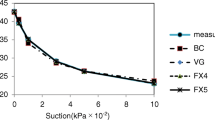Abstract
Compacted clay liners are commonly used as components of the lower portion of composite double liner systems for hazardous waste containment. Because the overlying leachate collection and removal systems and the FMLs are not perfect leachate still comes into contact with the lower liner and thus makes it critical that the clay liner component be constructed to achieve the lowest possible hydraulic conductivity. This research was conducted to evaluate the effects of clod size on the hydraulic conductivity of compacted soils and the uniformity of conductivity with depth within a lift of compacted soil. Two subsoils, one from the Beaumont series (smectitic) and one from the Kosse series (kaolinitic), were evaluated in the laboratory and then compacted in large fixed wall permeameters using maximum clod sizes of <2.5, <5.0, and <7.5 cm to a compacted lift thickness of 23 cm. Measurements were made of the hydraulic conductivity of the entire lift, the lower two thirds of the lift, and the lower one third of the lift. The results show that the conductivity of the lower one third of the lift can be as great as 8.7 times that measured for the entire lift and indicates that liners need to be constructed using thin lifts to achieve more uniform low conductivity throughout the liner. The data also indicated that under the carefully controlled conditions of this study and with the clod sizes used, the clod size did not have a significant effect on the hydraulic conductivity of the soils tested. Soil bulk density was poorly correlated with hydraulic conductivity and indicates that measuring the bulk density of a compacted soil is an inadequate method for assuring low hydraulic conductivity. Measurements of the time to the first appearance of leachate indicated that 8 to 17 d are required for water to penetrate a 23 cm thick compacted liner with an average conductivity of 1 × 10−7 cm s−1.
Similar content being viewed by others
References
Anderson, D. C., Brown, K. W., and Thomas, J. C.: 1985, Waste Management and Res. 3, 339.
Bass, J. M., Lyman, W. J., and Tratnyek, J. P.: 1985, ‘Assessment of Synthetic Membrane Successes and Failures at Waste Storage and Disposal Sites’, EPA/600/S2-85/100.
Benson, C. H. and Daniel, D. E.: 1991, J. Geotechn. Eng. 116, 1231.
Brown, K. W. and Thomas, J. C.: 1988, J. Hazardous Math. 18, 179.
Brown, K. W., Thomas, J. C., and Green, J. W.: 1986, Hazardous Waste & Hazardous Math. 3, 1.
Daniel, D. E.: 1984, J. Geotechnical Eng. 110, 285.
Daniel, D. E. and Brown, K. W.: 1987, ‘Landfill Liners: How Well do They Work and What is Their Future?’, in J. R. Gronow, A. N. Schofield, and R. K. Jain (eds.), Land Disposal of Hazardous Waste: Engineering and Environmental Issues, pp. 235–244.
Daniel, D. E., Shackelford, C. D., Liao, W. P., and Liljestrand, H. M.: 1991, ‘Rate of Flow of Leachate Through Clay Soil Liners’ EPA/600/S2-91/021, USEPA, Risk Reduction Engineering Lab., Cincinnati, Ohio.
Elsbury, B. R., Sraders, G. A., Anderson, D. C., Rehage, G. A., and Daniel, D. E.: ‘Field and Laboratory Testing of a Compacted Soil Liner’. Final Report EPA Contract No. 68-03-3250, Office of Research and Development, USEPA, Cincinnati, Ohio.
EPA, 1989. ‘Requirements for Hazardous Waste Landfill Design, Construction and Closure’, EPA/ 625/4-89/022.
Gee, G. W. and Bauder, J. W.: 1986, ‘Particle-size Analysis’, in A. Klute (ed.), Methods of Soil Analysis Part 1. Physical and Mineralogical Methods, Agronomy Monograph No. 9 (2nd Edition), American Society of Agronomy, Inc. Madison, Wisconsin, pp. 383–412.
Gunkel, R. C.: 1981, ‘Membrane Liner Systems for Hazardous Waste Landfills’, in D. W. Shultz (ed.), Land Disposal: Hazardous Waste, Proceedings of the Seventh Annual Research Symposium, Philadelphia, PA, March 16–18, EPA-600/9-81-002b, pp. 131–139.
Haxo, H. E. and Lahey, T. P.: 1988, Hazardous Waste & Hazardous Matls. 5, 275.
Laine, D. L. and Miklas, M. P.: 1989, Detection and Location of Leaks in Geomembrane Liners Using an Electrical Method: Case Histories, in Superfund '89 Proceedings of the 10th National Conference, November 27–29, Washington, DC, pp. 35–40.
Whittig, L. D. and Allardice, W. R.: 1986, ‘X-Ray Diffraction Techniques’, in A. Klute, (ed.), Methods of Soil Analysis, Part 1. Physical and Mineralogical Methods, Agronomy Monograph No. 9 (2nd Edition). American Society of Agronomy, Inc. Madison, Wisconsin, pp. 331–362.
Author information
Authors and Affiliations
Additional information
Contribution of the Texas Agricultural Experiment Station, Texas A&M University System, College Station, TX 77843. This work was supperted in part through cooperative agreement CR 813444-01 from the United States EPA and grant 89-06445 from the Waste Minimization and Management Center at North Carolina State University.
Rights and permissions
About this article
Cite this article
Thomas, J.C., Brown, K.W. Depth variations in hydraulic conductivity within a single lift of compacted clay. Water Air Soil Pollut 65, 371–380 (1992). https://doi.org/10.1007/BF00479899
Received:
Revised:
Issue Date:
DOI: https://doi.org/10.1007/BF00479899




